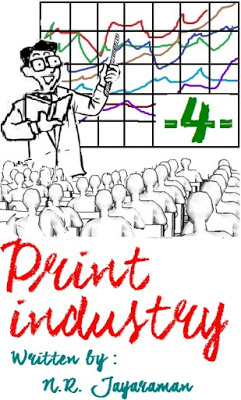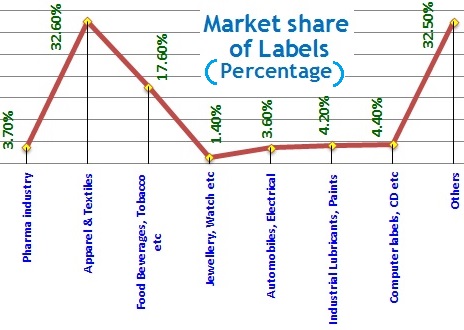
Print Industry – 4

The next major sector that contributes to the growth of the print industry is the Label printing. The label printing industry is one of the fastest growing one in India and is reportedly growing by 15 % to 17 % annually. Various types of Labels are produced both as simple labels and with invisible security features for several products for Pharma, Food, Automobile and other consumer products. The market share of Labels can be seen from the data shown below.

Like how no product is sold without some sort of a packing, no product too is sold without printed Label affixed over them since the tendency of the public is to first notice details on the pack before purchase of the product and therefore the suppliers stick Labels over their products.
The Label printing is further divided into normal Labels and Labels incorporated with security features as a safeguard against counterfeiting and forgery. Many industries demand Labels with hidden Security features to identify their genuine products in the market. Therefore there is a clamor for this aspect on Labels and thus the larger use of Labels help the print industry grow.
As said earlier there are many types of self adhesive sticker Labels produced incorporating security features for boxes and cartons to prevent sale of forged products with counterfeit labels. The market for them is very high. Bar code Labels, Colour changing Labels, Holographic tapes, tamper evident Labels, Destructive Labels, brand protection by invisible taggants in ink detectable through special device supplied by the manufacturer of the said label and Void seals etc are some to mention.
The Label Printing industry is marching forward in India. As per the claims of Indian Label Printers Association, this industry has recorded highest growth rate of 19%. According to the industry reports the Bar-coded labels are also growing by 30-35%. The Label industries growth which was around 18.42 billion Indian rupees in the year 2002-03 expected to be 1.4 billion US dollar equivalent to 67.68 billion* in Indian rupees as on 2002-03 (* The conversion rate of US dollar against Indian rupees was approx Rs 48.40 per US dollar during 2002-03)
From the press release of Markets and Markets, India (http://www.marketsandmarkets.com/PressReleases/security-labels.asp) it is understood that :
Quote:-
………The food & beverage segment is projected to be the largest market in the next five years. The demand from the food & beverage sector is expected to experience a higher growth rate, mainly because of the growing demand for packaged and branded products, and consumer awareness toward the authenticity of the product. Beverage manufacturers widely use security labels on bottles owing to the high durability, aesthetic appeal, and brand positioning which they offer. Asia-Pacific with emerging economies like China and India will drive the security labels market………….
Security labels market, by identification method, is classified into three segments, namely bar codes, radio-frequency identification and holographic. Bar codes present a cost-effective and reliable method for collecting any kind of necessary data. Bar codes are widely used by industries such as consumer durable, retail, and transportation & logistics for keeping a track of their products, as well as for tracing outgoing shipments and equipment.
-:Unquote
Two more articles in respect of the Label industry mentioned below will be of interest to this study. One of the two articles under the heading ‘Labels and narrow web’ (http://www.labelandnarrowweb.com/issues/2009-01/view_features/indias-label-markets/) reads as below:
Quote:-
India’s Label Markets — by Steve Katz | January 14, 2009 goes on to say that:
…………Mike Fairley of Tarsus, chair of the conference sessions, kicked off the program by revealing the findings of a 2008 survey of 500 Indian label converters. The survey’s findings point toward a range of trends in the market and, according to Fairley, “ever increasing growth.” He says it’s notable to point out that in the wake of the struggling global economy, India is in far better position to weather the global economic crisis. A big reason for this, he says, is because India is far less dependent on exports than other emerging markets, such as China, for example.
“I see long term potential for high growth for the next 10 years,” Fairley says. “India is at the beginning of major retail growth. The industrial market is massively expanding and this has led to many small label companies being formed in India.”
Survey results showed that in 2008, 49 percent of converters reported sales growth of 10 to 20 percent, and 25 percent of those reporting growth of more than 20 percent. Over 84 percent of converters are printing self-adhesive labels, which is significant considering that PSA versus wet-glue labels was a major topic of conversation among the show’s exhibitors and attendees…………
……………. While brand protection and anti-counterfeiting is certainly a hot topic in India’s label market, there are other notable trends. The aforementioned survey of label converters revealed the printing processes being used, and which ones are on the rise. The survey’s findings conclude that 55 percent of India’s label printers use a screen printing process, 50 percent flexography, 35 percent offset, and 30 percent letterpress. Fairley noted that seemingly “coming out of nowhere” is the use of UV flexo, which is reported to be in use among 27 percent of the converters surveyed…………………
:- Unquote
Labels & Labeling another magazine on Labels (http://www.labelsandlabeling.com/news/latest/indian-label-market-set-grow-20-percent ) has published the following news.
Quote:-
Indian label market set to grow by 20 percent: article dated 10th June 2007 goes on to say thus:
………The Indian label market is set to grow by 20 percent in the next two to three years, Prof P V Narayanan, of the SIES School of Packaging in Mumbai, told the world’s self-adhesive label trade association at the FINAT World Congress in Berlin.
‘Over the last ten years India has seen its retail economy fortunes soar at ten to 15 per cent growth rates annually, to a present value of between $180bn and $230bn, and this is likely to continue over an extended period,’ Prof Narayanan said.
This growth is reflected in the expansion of its label printing industry, which last year teamed up with FINAT and VskE, the German trade association, to create the Indian-European Label Exchange, which helps set India on a target of printing at least three billion square meters of labels a year by 2009-10.
By comparison, the whole of Europe produced 5.2bn square meters of labels in 2006.
Prof Narayanan said: ‘This trend indicates that India will double its 3.2 percent of world market share to 6.3 percent in square meter terms by that time.’
Talking of the Indian-European Label Exchange, which was formed last year, Prof Narayanan said that three factors came into play – curiosity which created a lot of interest in his local market, which led to the opportunity to meet and explore possibilities which in turn promised added value to both markets.
Prof Narayanan told the Congress the business-to-business matchmaking event had been well received by the members of LMAI and should be repeated on a biannual basis. …………
:- Unquote
Security Printing : Documents and Currencies
The Indian market for security printing was valued at $424.6 million in 2009 had reached $927.4 million in 2012, at a CAGR of 12.2% for 2009–12 period as shown in Table 3.8. Other security printing includes cheques, demand drafts, telephone bills, Exam papers and Certificates in the education sector, tickets in the travel segment, government documents like Passports, Driving Licenses, bar codes, etc. Security printing can be divided into financial (banknotes, cheques, drafts) and non-financial (stamps, passports, driving licenses, identity cards, personal certificates, dividend warrants). This also includes Currencies Printing which is a separate subject. But their growth too is responsible for the growth of the print industry as newer and newer technologies and machineries & equipments are procured in these units to march ahead of the counterfeiters and speed in delivery. Details of growth in the Currency printing is not discussed in detail here for obvious reasons.
Other prints – irregular in nature
In addition to all the sectors and industries that aid the growth of the print industry, the leaflets and pamphlets regularly issued by the advertising sectors for various products and programs have not been included in this study as much of them remains unaccounted and issued instantly. Expression of huge discount sales of the products to cultural programs to social functions and other events including election time reproductions are not viewed as regular reproductions but are produced through small time presses or by desktop publishing at short intervals without planning. Even though the direct percentage of their contribution to the growth of the print industry is not accounted, the fluctuating sale of small time printing paper and the printing inks in the market will indicate that the contribution of this sector to the growth of the print industry could be anywhere between 4 -5 % as on all India level such activities are very high.













Recent Comments